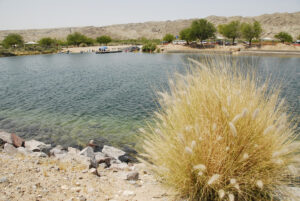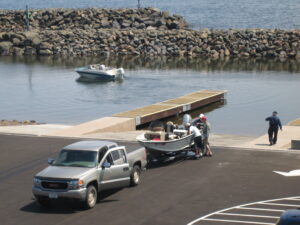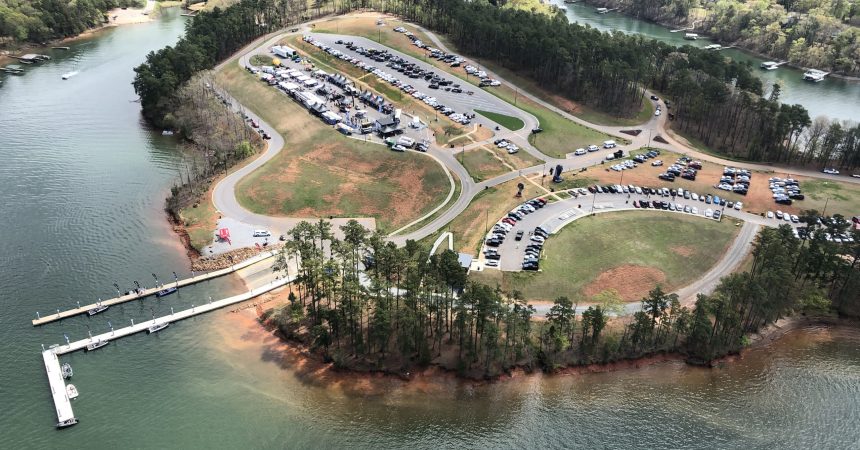By Tim Allard.
Title image: The public boating access site at Green Pond, South Carolina, which is supported by Sport Fish Restoration funding. Courtesy Alex Kostik, Anderson County Parks.
From simple, single lane boat launches to massive, modernized marinas, Americans have access to thousands of safe, clean, well-maintained boating and fishing access sites nationwide. Many of these sites are constructed and maintained as a result of a successful conservation partnership, which begins with fishing equipment manufacturers who pay excise taxes and a motor boat fuel tax collected through the Sport Fish Restoration (SFR) Act. The U.S. Fish and Wildlife Service (USFWS) then administers funds through the SFR program to state fish and wildlife agencies to create and improve public boating access facilities and fishing opportunities.
The following three access sites illustrate the significance of this partnership. These facilities provide safe opportunities for families to enjoy time on the water, are important fixtures within their communities, and encourage growth in boating and angling participation and spending.
Green Pond Landing & Event Center, SC (pictured above)
Fishing industry paid excise taxes and the motorboat fuel tax are helping Anderson County Parks (ACP) realize a vision of building a premium, lakeside event center focused on boating and fishing. Opened in 2014, Green Pond Landing & Event Center sits on the shores of 56,000-acre Lake Hartwell, one of the biggest and most favored recreation waterbodies in the Southeast. While the facility continues progressing towards its planned, final design, its three-lane boat ramp is one of the most popular in Anderson County and the facility already has a reputation as being one of the top fishing tournament sites in the country.
“Sport Fish [Restoration] funds played a significant role in the first phase of development, which actually pulled in the [Bassmaster] Classic to Green Pond for the first time in 2015,” said Matt Schell, a Parks Department Manager with ACP.
These funds have also subsequently supported two additional phases of development at Green Pond. These were in preparation for the 2018 and upcoming 2022 Bassmaster Classic events, one of the world’s most prestigious professional bass tournaments.
Green Pond also recently hosted its largest tournament to date. It consisted of 398 teams for the The Bass Federation’s High School Fishing World Finals and National Championship, in which over $3 million in scholarships and prizes were up for grabs by the student anglers.
Green Pond’s ability to support these major events, benefiting both industry and public alike, would not be possible without SFR funding, which currently totals $2.4 million for this project. Currently, SFR funds are helping ACP build a 400-foot remote courtesy dock and weigh-in site for fishing tournaments. The dock will improve boating safety by reducing traffic congestion around the boat ramp and main docks during events. It will also provide more transient public dock space.
Green Pond also attracts an array of recreational boaters in addition to anglers. The ADA-accessible facility offers 200 paved truck/trailer spaces and 100 single car spaces, an extremely well-laid out design, and a two-story bathroom facility.
“We are equipped to handle the tri-axle [trailers], the pontoons, the cabin cruisers,” Schell said. “People come to Green Pond because of the ease of use.”
Thanks to SFR funds, Green Pond benefits boaters, anglers, and fishing equipment and boating manufacturers by providing excellent boating access to Lake Hartwell and attracting regional, national, and international lakeside tournaments. Bringing in these events promotes interest and spending related to angling and boating. More, fishing tournaments support upstate South Carolina’s economy by generating the need for accommodations, fuel, food, and other recreational supplies and creates residual tourism in the future.
Big Bend State Recreation Area, NV

“Nevada is the most arid state in the nation,” said Lawrence Riley, Wildlife and Sport Fish Restoration Program Manager, USFWS. “Sometimes folks think that being in an arid place relegates the importance of fishing and boating…quite the opposite. People are drawn to water and scarcity makes the heart latch on to important water-based recreation opportunities.”
Nevada’s Big Bend State Recreation Area in Laughlin is such an oasis and recently had its public boating access improved thanks in part to SFR funding. Located in a backwater lagoon, its boat launch and beach are popular with power boaters, anglers, kayakers, rafters, and swimmers eager to access the Colorado River’s cool waters and find relief from Southern Nevada’s scorching heat.
In 2017, the Nevada Department of Wildlife (NDOW) and the Nevada State Parks Department (NSPD) undertook a project to combat erosion and drainage issues that were limiting public boating access at Big Bend. The initiative received a $590,150 SFR grant, which was matched state funds at 25 percent with $196,717.
This funding also allowed for the dredging of built-up sediment from the lagoon to provide a safe navigation depth for watercraft accessing the site. The beach retaining wall was bolstered with sheet piling. Sand taken from the river’s sediment traps was cleaned and used to enhance the beach landing for visiting watercraft. NSPD also acquired a sand-sifting machine for removing debris and garbage, which assists with ongoing beach maintenance to ensure easy, safe access for boaters and families.
SFR funds also contributed to better amenities at Big Bend. A new wood boat dock was installed and ADA accessible pathways were also created, connecting the newly installed shade structures, restroom facilities, and the accessible pathway travelling along the beach to the water.
Over three million people a year visit the Laughlin/Bullhead City area, increasing local populations by the thousands in spring and summer. While some may come to gamble at Laughlin’s famous casinos, many travel to Big Bend to boat, fish, and swim in the cool waters of the Colorado River. Thanks to fishing manufacturer paid excise taxes and the motor boat fuel tax, this site continues to provide public opportunities for enjoying safe, clean, water-based recreational activities.
McQuade Public Access and Small Craft Harbor, MN
Situated 12 miles from Duluth along Highway 61, the McQuade Small Craft Harbor on the northern shore of Lake Superior is another example of how SFR funding provides the public with safe boating and fishing access. McQuade is part of Minnesota’s Lake Superior small craft harbors and protected accesses, a series of facilities serving the dual purpose of providing public boating access sites and places of refuge for boaters when the largest of all the Great Lakes takes a turn for the worse.

“The shoreline on the Minnesota side is rocks and cliffs,” Kent Skaar said, Boat Access Senior Project Manager, Minnesota Department of Natural Resources (MDNR). “[McQuade is] a public access, principally, but the breakwater and the basin behind it was really intended to be a safe harbor as well for boaters.”
Opened in 2008, McQuade received $100,000 in SFR contributions. The facility has three ramps for boat launching and retrieval with height adjustable docks. It also has a kayak launch in the southwest corner, giving paddlers an access site for exploring the Lake Superior State Water Trail. McQuade’s sheltered, three-acre harbor basin also has two staging/emergency docks and a red navigation light on the east breakwater.
Accessibility-designated amenities include: a pedestrian tunnel under the highway, a shore fishing platform on the east breakwater, a breakwater walk, a viewing area, and restrooms. It provides paved parking for 54 vehicle/trailers (3 accessible) and an additional 23 vehicle parking. McQuade features a vehicle underpass and a pedestrian tunnel connecting the parking area to the harbor, providing a safe travel route under busy Highway 61.
“It is a busy place. One, when the fishing’s good, certainly… [and] on a good day, the recreational boating along the shore is pretty substantial,” Skaar said.
Thanks to manufacturers’ excise taxes and the motor boat fuel tax, boaters, anglers, and fishing equipment and boating manufacturers benefit from McQuade’s boating and fishing access throughout the rugged, rocky northern shore of Lake Superior. SFR funding is equally critical for MNDR’s ability to directly operate and maintain approximately 1600 public water access facilities and be a cooperative partner with local units of government on several hundred additional sites throughout the state, which would not exist otherwise, according to Skaar.
“The Sport Fish [Restoration] Program and the Boating Safety Program are the real drivers of our development of these facilities. Although the State of Minnesota, as an example, does appropriate dollars through a similar mechanism at a state level, it really is the Sport Fish and Boating Safety money that allows those state dollars to step in and make a difference,” Skaar said.
Supporting The Boating Boom
The above sites provide a glimpse into the importance of the conservation partnership that helps provide thousands of safe, clean boating and fishing public access sites nationwide. Fishing equipment manufacturers pay excise taxes into the SFR fund and when combined with the motor boat fuel tax, provide a vital source of funding for state agencies in managing the building, operation, and maintenance of boat ramps, boat slips, pump-out stations, and other boating infrastructure. And, with U.S. boat sales reaching a 13-year high in 2020 and remaining elevated in so far in 2021, according to the National Marine Manufacturers Association, the efforts of all parties involved are as significant as ever for boaters, anglers, and fishing equipment and boating manufacturers.

